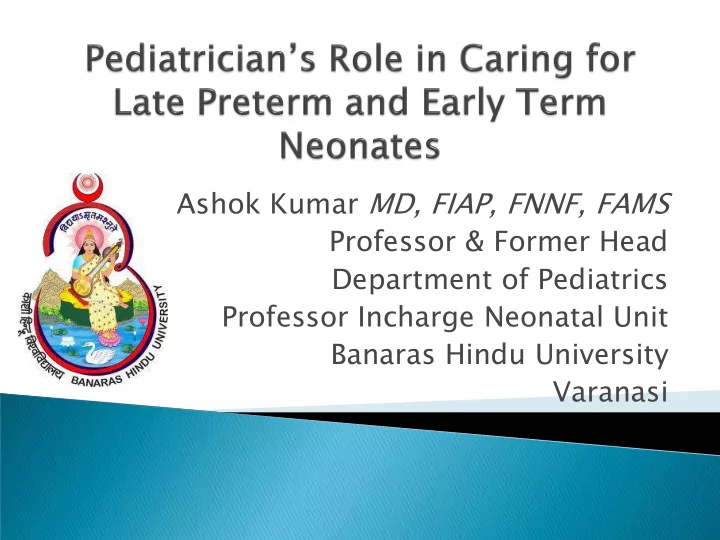

Ashok Kumar MD, FIAP, FNNF, FAMS Professor & Former Head Department of Pediatrics Professor Incharge Neonatal Unit Banaras Hindu University Varanasi
Definitions of late preterm & early term Magnitude of the problem Health problems of these infants General principals of management Prevention
Gestational age 34-0/7 to 36-6/7 wk Earlier they were known as near term
Ne Near ar Term rm La Late Pre reter erm Maturity Physiologic & metabolic immaturity Similar risk of morbidity & Higher risk of morbidity & mortality as in term mortality compared to infants term infants
Term pregnancy extends from 37-0/7 wk to 41-6/7 wk Earlier it was thought that that the outcome is uniform and good across 5 weeks’ gestation in term pregnancy
JAM AMA A 2013; 3; 309: : 2445 Early Term: 37 0/7 wk – 38 6/7 wk Full Term: 39 0/7 wk – 40 6/7 wk Late Term: 41 0/7 wk- 41 6/7 wk Post Term: 42 wk and beyond
Gestat tation ion (wk) k) Morb rbidity idity ra rate (%) %) 3.3 38 37 5.9 12.5 36 35 25 51.2 34
Increasing maternal age Fertility treatment Multiple births C-section Increasing maternal obesity Maternal comorbid conditions Non medical reasons Inaccurate gestational age
NICU U admission Exce cessive ve weight ght loss Respiratory morbidities- Sepsis TTN/RDS/Apnea/Respiratory failure Temperature instability Neurological morbidities Hypoglycemia Longer hospital stay Hyperbilirubinemia Hospital readmission Feeding difficulties Neonatal and infant mortality
aOR aOR Gest Ge st. RDS TTN TTN Pneum eum Resp Surfact act Ventil ntila Osc scillat llat wk wk onia Failure re ant tor tor or or 39-40 1 1 1 1 1 1 1 38 1.1 1 0.9 1.4 1.1 1.2 0.9 37 3.1 2.5 1.7 2.8 4.8 2.8 2.8 36 9.1 6.1 3.6 6.2 16.1 7.3 7.1 35 21.9 11.1 6.6 4.9 35.2 9.8 12.3 34 41.1 14.7 7.6 10.5 58.5 13.9 18.8
Pa Paediatri diatrics cs 124:234-240, 0, 2009 Pa Paediatri diatrics cs 124:234-240, 0, 2009 Pedia iatric rics 124:234-240, 2009 2009
Innate immunity is not well developed Higher risk of infections
1. Role of Pattern Recognition Receptors in Recognition of Bacteria and Viruses Membr mbrane bou ound Cytoplasm smic PRRs: PRRs: RIG-1, MDA DA5, PKR KR, C5aR, TLRs TLRs (1, 5 and OAS 8) iiiiiiii iiiiiiii iiiiiiii iiiiiiii iiiiiiii iiiiiiii iiiiiiii iiiiiiii iiiiiiii iiiiiiii iiiiiii Singh et al, PLoS ONE, 2013
LBW NBW No. of gene down-regulated = 1065 No. of gene up-regulated = 326 Colour Range (fold change) -2 0 2 Fold changes are represented on logarithmic scale Singh et al, PLoS ONE, 2013
Netosis-neutrophil extracellular trap formation
Neutrophil Extracellular Trap formation (NETs) Antimicrobial Beneficial peptides & Suicide chromatin Granules KIL ILLLIN ING G OF OF BACTE TERI RIA Neutrophil Bact cteria ria NETOSIS MICROBI ROBIAL AL MEMBRAN RANE RUPTURE URE AND CHROMATIN OMATIN RELEASE SE INFECT FECTION ION
NETOSI NE SIS S in in L LBW Ne Newborn rns s LBW UNINDUCED LBW INDUCED LBW INDUCED LBW INDUCED L B W NBW INDUCED NBW INDUCED NBW INDUCED NBW UNINDUCED N B W Green : Syto 13a live cell intra-nuclear DNA stain Red : Sytox- orange a Extracellular DNA stain
Signalling pathway which conrols Netosis is defective in LBW infants (Singh VV, Chauhan SK, Rai R, Kumar A, Rai G: Decreased toll-like receptor-4/myeloid differentiation factor 88 response leads to defective interleukin-1beta production in term low birth weight newborn) Pediatr Infect Dis J 2014, 33:1270-1276 .
Close monitoring The focus of care is individualized depending on the specific medical problems Counseling of parents about the possible morbidities, admission to NICU, prolonged birth hospitalization, and rehospitalization
Delivery room resuscitation Temp maintenance Respiratory distress Feeding issues/hypoglycemia Hyperbilirubinemia Sepsis
Hyperbilirubinemia Poor feeding Excessive weight loss Suspected sepsis
Education of mothers and families regarding long-term follow up Early intervention and developmental services may be indicated, especially for those who have problems with cognition, learning, and behavioral problems
Avoidance of non-medically indicated delivery before 39 weeks Late preterm births have shown declining trend in recent years in US Early term births are continuing to rise Policy changes are needed to prevent early births
Hard-stop policy: hospital passes an order not to deliver early if it is not indicated Soft-stop policy: Obstetricians agree not to perform non-medically indicated delivery before 39 weeks Education program All 3 approaches were effective to reduce the rate but hard-stop policy was most effective (Am J Obstet Gynecol 2010)
Documentation of fetal lung maturity does not justify early non-medically indicated delivery
Late preterm and early term infants are physiologically and metabolically immature Higher risks of morbidity and mortality and long term health related rsiks Efforts are needed to reduce non-indicated early births
Recommend
More recommend